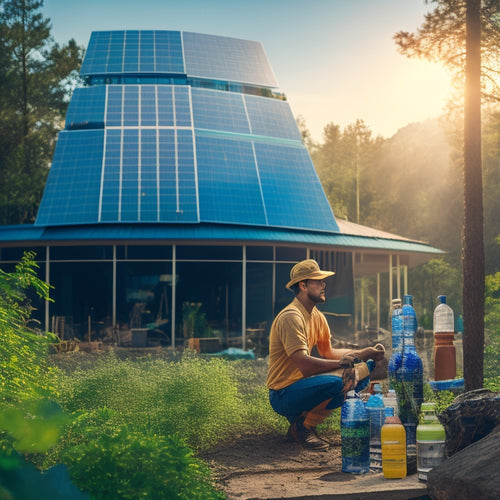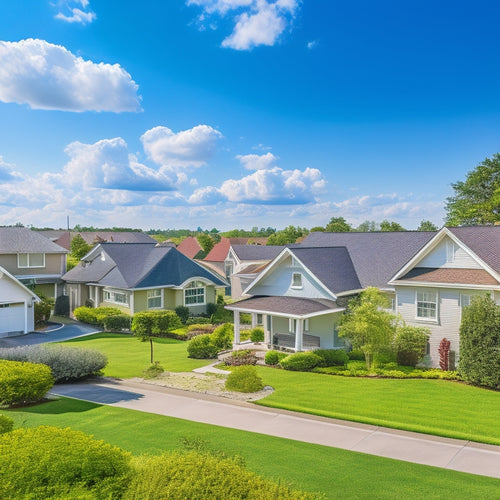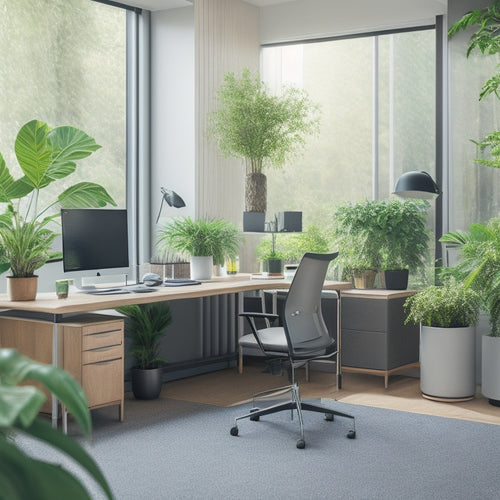
5 Passive Solar Home Design Tips for Energy Efficiency
Share
To maximize energy efficiency in your home, you can start by orienting it to capture ideal sunlight, using thermal mass materials like concrete or brick paired with the right insulation. Strategically place windows, such as south-facing ones with low-e glass, to utilize winter sunlight and reduce summer heat gain. Landscaping with deciduous trees and shade structures can also help regulate temperatures. Additionally, design for cross ventilation to enhance natural cooling, and consider clerestory windows or solar tubes for added light and heat. By incorporating these passive solar design principles, you'll be well on your way to creating a more sustainable and energy-efficient home - and there's even more to investigate.
Key Takeaways
- Optimize home orientation to maximize winter sunlight and heat while minimizing summer sun exposure for energy efficiency.
- Combine thermal mass with appropriate insulation to regulate indoor climate and reduce energy consumption.
- Strategically place windows with energy-efficient glass coatings to capture winter sunlight and reduce summer heat gain.
- Incorporate landscaping elements like deciduous trees and shade structures to control sunlight and reduce cooling needs.
- Design for natural cooling ventilation by leveraging cross ventilation, clerestory windows, and venting hot air to reduce energy usage.
Orienting for Optimal Sunlight
When building a passive solar home, orienting your house to capture ideal sunlight is essential.
You'll want to carefully study the sun's path across the sky to determine the best orientation for your home.
Consider the seasonal adjustments your home will need to make to maximize natural light and heat. In the winter, you'll want to allow for longer sun rays to warm your home, while in the summer, you'll want to block out harsh rays to keep your home cool.
By incorporating solar panels and Energy Storage systems renewable energy sources, you can further reduce your reliance on artificial lighting and heating.
With a well-designed passive solar home, you'll be able to bask in the warmth and light of the sun, while minimizing your impact on the environment.
Insulation for Thermal Mass
In harmony with the sun's cycles, your passive solar home's thermal mass - think concrete, brick, or adobe - absorbs and releases heat, regulating your indoor climate. To maximize this natural process, you'll want to pair your thermal mass materials with the right insulation types.
| Thermal Mass Materials | Insulation Types | R-Value |
|---|---|---|
| Concrete | Fiberglass batts | R-3.5 to R-4.5 |
| Brick | Spray foam | R-6 to R-7 |
| Adobe | Radiant barrier | R-2 to R-3 |
| Rammed earth | Reflective insulation | R-2 to R-4 |
Window Placement Strategies
You're carefully crafting your passive solar home's thermal mass and insulation, but don't forget that strategic window placement is essential for utilizing natural light and heat.
By thoughtfully selecting window types and glass coatings, you can maximize energy efficiency. For instance, incorporating renewable energy sources like solar panels into your design can further reduce your carbon footprint.
Additionally, investing in energy storage systems can maintain a stable power supply and guarantee efficient energy distribution.
For example, south-facing windows with low-e glass coatings can capture winter sunlight and heat, while west-facing windows with tinted glass can reduce summer heat gain.
Consider larger windows on south-facing walls to absorb natural light and heat, and smaller windows on north-facing walls to minimize heat loss.
This deliberate window placement strategy will help you create a comfortable, energy-efficient living space that's in harmony with nature.
Landscaping for Shade Control
Beyond window placement, your passive solar home's energy efficiency also relies on strategic outdoor design for shade control. By incorporating deciduous trees into your outdoor design, you can block harsh summer sun and allow natural light to warm your home during winter.
Additionally, considering Renewable Energy Solutions can further enhance your home's energy efficiency, such as installing solar panels or wind turbines to generate electricity.
Shade structures, such as pergolas or trellises, can also be used to filter sunlight and create comfortable outdoor spaces. When selecting plants, choose species that provide shade without obstructing natural ventilation.
Consider native plants that require minimal maintenance and watering. A well-designed outdoor environment not only enhances your home's energy efficiency but also creates a beautiful, sustainable outdoor environment that offers you freedom from high energy bills and a deeper connection with nature.
Ventilation for Natural Cooling
Proper ventilation is key to utilizing natural cooling in your passive solar home, allowing you to slash those energy bills and breathe easy.
You'll want to design your home to maximize cross ventilation, which occurs when air enters through one window and exits through another, creating a cooling breeze. To optimize airflow patterns, consider the layout of your windows, doors, and interior spaces.
For example, open windows on opposite sides of your home to create a cooling flow of air. Use clerestory windows, skylights, or solar tubes to bring in natural light and heat, then vent hot air out through upper windows or vents.
Frequently Asked Questions
Can Passive Solar Design Be Applied to Existing Homes?
You can breathe new life into your existing home by applying passive solar design principles, incorporating retrofitting strategies like reorienting windows to optimize natural light and heat, and adjusting window orientation to capture the sun's energy.
How Does Climate Affect Passive Solar Home Design?
You'll be surprised to know that 80% of the world's population lives in areas with high solar irradiance, making climate an essential factor! As you design, consider your climate zone and make seasonal adjustments to optimize natural light and heat, ensuring a comfortable, energy-efficient space that's customized to your environment.
Are Passive Solar Homes More Expensive to Build?
When building a dream home, you'll wonder if eco-friendly designs break the bank. While upfront costs might be higher, a cost comparison reveals long-term savings through reduced energy bills, making your sustainable haven a smart, financially freeing choice.
Can I Incorporate Renewable Energy Systems Into My Design?
You can seamlessly integrate solar energy systems into your design, creating a harmonious balance between nature and technology, and enjoying the freedom to utilize renewable power while reducing your carbon footprint.
Do Passive Solar Homes Require Special Maintenance?
Imagine waking up in the Earthship Community's Taos, New Mexico, homes, where natural ventilation strategies and thermal mass walls minimize upkeep; you'll find that, surprisingly, your passive solar home requires less maintenance, freeing you to enjoy life off the grid!
Related Posts
-

What Tax Deductions Apply to Sustainable Building Materials?
You can claim various tax deductions for sustainable building materials, thanks to over 40 federal tax incentives sup...
-

What Cool Roof Tax Breaks Can Homeowners Claim?
You can claim federal tax credits of up to $500 and state and local incentives for installing cool roofs, which not o...
-

What Air Purifiers Save Energy in Work Areas?
You can cut energy costs and reduce your carbon footprint by choosing air purifiers designed with energy efficiency i...


